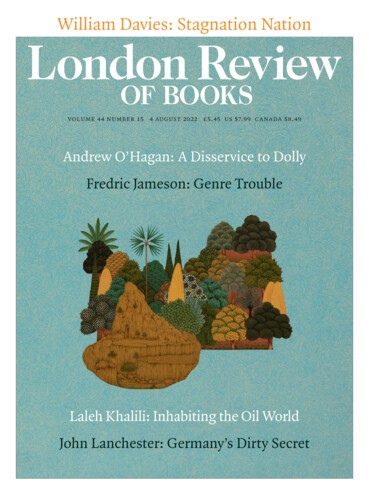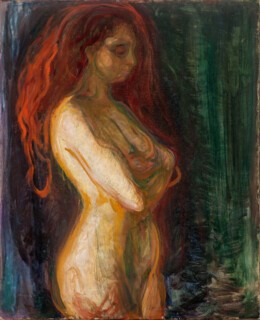Edvard Munch ’s paintings have been described as ‘confessional’. The term implies narcissism, but Munch’s talent is empathetic. As a brother to three sisters, his insight into female experience was personal. He understood women and girls. He watched them closely.
Munch’s mother died of TB when he was five. His older sister Sophie died, also of TB, when he was thirteen. The consolation for loss was female, too. His mother’s sister Karen raised him. She was a benign influence. Edvard said of ‘Aunt Karen’ that ‘it was probably she who contributed most to my becoming a painter.’ He was close to his younger sister Inger who became the subject of his first great painting.
Munch questioned his own place in the world, his identity, his masculinity. He was acutely aware of his difference. In the second room of the exhibition Edvard Munch: Masterpieces from Bergen at the Courtauld (until 4 September) there is an extraordinary painting, Woman in Three Stages, painted in 1894 when Munch was thirty. The three women might represent the three stages of the life cycle – youth, maturity, old age – yet they appear to be the same age. They could be sisters. A man stands isolated to the right of the canvas, his eyes cast down; he is boxed in by tall tree trunks. The painting made me think of Branwell Brontë’s famous ‘Pillar Portrait’ in the National Portrait Gallery, depicting his sisters Charlotte, Emily and Anne with his own self-portrait in the group obliterated: a ghostly absence that haunts the composition in the form of a tall column of paint. Branwell, as the only brother in a family of sisters, must have had a similar struggle to Edvard. But Branwell never resolved the gender insecurity he experienced. The portraits of his sisters remain caricatures. He didn’t enter the life of his subjects as Munch was able to do.
The shadowy figure of the man on the right in Munch’s painting is so introspective it is nearly a negation. He is separated from the three women to his left by a strange bloody form – a red flower, perhaps, or a vulva. When he was 44, Munch made a charcoal and pencil study, Sketch of a Vulva. Moody whorls of charcoal surround the central hole. It conjures up the face in his most famous painting, The Scream, in which the wavy lines, marking the fingers of the raised hands, encircle the hole of the screaming figure’s mouth. The anguished genderless human being stands at the front of the composition: a gateway to the past and to the future, to birth and to death.
In Woman in Three Stages, the red vulva-flower in the foreground also resembles a gateway, a threshold. Time drops away vertiginously behind it, in the swooping lines of the shore. The girl in white stands on the shore and regards an unseen horizon. The rushing perspective hurtles from a figure or form in the foreground: a motif Munch uses again and again. The lines that lead away and dwindle to a far point on the horizon could be either a path or the wake of a ship, symbolising a journey or a passing, a birth or a death.
Munch seems especially concerned with beginnings and endings. This awareness isolated him. He couldn’t live in the present because it was always overshadowed by the past or by the future. He found it difficult to sustain a relationship. He had many liaisons but they didn’t last long. He had no children.
There is just one clear self-portrait in the exhibition. Munch had suffered a nervous breakdown and was admitted to a clinic in Copenhagen, his inherent mental instability further unbalanced by heavy drinking. His doctor advised that he associate with ‘poison-free’ women: virtuous types like the nurses in their white dresses who looked after him. There is a photograph in the exhibition catalogue of Munch being tended to by a smiling nurse. He watches her tray-bearing advance with a hunted expression: I don’t think he’s at all certain that this prescription will be his cure. In response to his sanitised environment, he paints himself surrounded by bright slashing horizontal angry lines, the colour of war paint. His face is as defensive as a closed fist.
He was to live another 35 years after painting this self-portrait. His final painting – not in the exhibition – is testimony to the fixity of his intention. It is titled Self-Portrait: Between the Clock and the Bed and was completed shortly before his death aged eighty. He stands in defiance between the gateposts of life and death. His vision is unwavering and uncompromising.
Munch’s self-portraits are always questioning. I can tell they are a good likeness but I feel shut out by them. They have none of the intimacy of a Van Gogh self-portrait. They don’t allow the viewer in. Munch is on his guard; he doesn’t want to be seen. He brings none of the empathy that makes his portraits of women so psychologically revealing. He is more at home looking at a woman than he is looking at himself in the mirror. In this way, his paintings are a contrast to Tracey Emin, whose exhibition Tracey Emin/Edvard Munch: The Loneliness of the Soul was shown last year at the Royal Academy. Emin’s paintings focus on her own emotions and bodily experiences; Munch’s strength is to inhabit the lonely soul of an ‘other’.
In Nude in Profile towards the Right the sureness of the brushmarks testifies to an insider knowledge. This could be a self-portrait by the woman with the long flame-red hair because she inhabits the flesh of her body so intimately. The colour of her hair might suggest seduction, but I think it is her inner life that is the true subject matter. It’s a beautiful painting. I love the heavy scoring of the underdrawing left visible to suggest risk and movement. She is cupping her breasts familiarly, as she does when she’s alone. She is in a world of her own. There is nothing voyeuristic in the sentiment, however. She is allowing herself to be looked at. She is at ease with the man who is observing her.
Munch enters the soul of the little girl who looks out at the viewer from the village lane in Children Playing in the Street in Åsgårdstrand. The street plunges giddily away from her and stops at two figures – two men – in conversation in front of a group of houses. Three boys lie at her feet looking up at her. They are laughing. Are they teasing her? She is anxious and her blue eyes are frightened. She knows that her future will be different from theirs. She sees the challenges – sex, giving birth, motherhood, looking after a home, ageing, loneliness – that lie ahead for her.
Four Stages of Life shows four females: a smiling child in the foreground, hedged around by three grim women dressed in dark clothes. They bear down on her and oppress her. They are terrifying figures, like the Eumenides representing the threat of divine judgement. They become gradually more frightening as they age: the fourth is a white-haired witch. She is the little girl’s future.
There are no such fatalistic constraints imposed on his friend Marie Helene Holmboe in Munch’s depiction of her. Her future appears to be her own. She sits sideways on a viridian chair. She turns to face the viewer. Her arms are crossed on the arm of the chair. Her face is alive with intelligence. Her blue eyes brim with humour and wit. Her eyebrows are raised and her mouth is open: she is expressing her opinion without inhibition.
When, aged 25, Munch painted his first great painting, Summer Night. Inger on the Beach, what set him apart was his ability to portray the strangeness of difference, of other people, of a gender not his own, of a world in which he doesn’t belong. And he conveys that otherness with compassion. Inger is self-contained; she dwells in the mystery of herself. Munch is witness to the mystery. He records it, as he does the extraterrestrial boulders she sits among.
Send Letters To:
The Editor
London Review of Books,
28 Little Russell Street
London, WC1A 2HN
letters@lrb.co.uk
Please include name, address, and a telephone number.


